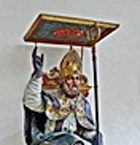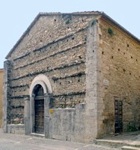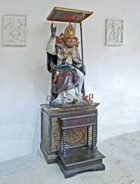
Processional statue of St Vincent (1638)
San Michele, Bevagna
According to the legend (BHL 8676), which seems to date to the 6th century, St Vincent was Bishop of Bevagna and martyred in the reign of the Emperor Diocletian. St Benignus, his deacon, predeceased him on 1st May in an unknown year. St Vincent died on 6th June in the year of the consuls “Bufus and Gallus”: this should probably read “Faustus and Gallus”, the consuls of 298 AD. He was buried at “Campo Salutis” near Bevagna (possibly the present Parco Silvestri).
This legend was later absorbed into the Legend of the Twelve Syrians, according to which St Brictius ordained St Vincent, his nephew, as Bishop of Bevagna. A version of the legend of St Vincent that was contained in the Leggendari del Duomo has been lost.

The church of San Michele contains two processional statues of St Vincent:
-
✴a polychrome wooden statue (1638); and

-
✴a silver statue (1785) by Peter Ramoser, which is kept in a chapel off the presbytery and accessible only on the feast of St Vincent.
Relics of St Vincent
As noted above, the church that was built outside Bevagna to house the relics was apparently destroyed by the Lombards in the 7th century. The relics were moved to what is now the Abbazia di San Vincenzo at Furlo in the Marche at the time of the Lombard occupation.
-
✴According to Sigebert of Gembloux, in his ‘Vita Deoderici, Mettensis Episcopi’ (Life of Bishop Theodoric of Metz), Bertraus, a representative of of Bishop Theoderic extracted some of the relics of St Vincent from a priest at Petram Pertusam, (presumably the Abbazia di San Vincenzo at Furlo) in 970 and sent them to Metz. In his ‘Chronicon’, Sigebert identified this saint as St Vincent of Mevania.
-
✴Some of them seem found their way to Lucca in 1184. As noted in the page on Saints of Trevi, Bovara, outside Trevi, claimed to be the birth place of these saints. Relics were returned from Lucca to Trevi in 1703, an event commemorated by the commission of this fresco outside Palazzo Comunale, Trevi (see the relevant Walk), which depicts the Madonna and Child with St Emilianus, the patron saint of Trevi, and SS Vincent and Benignus.






